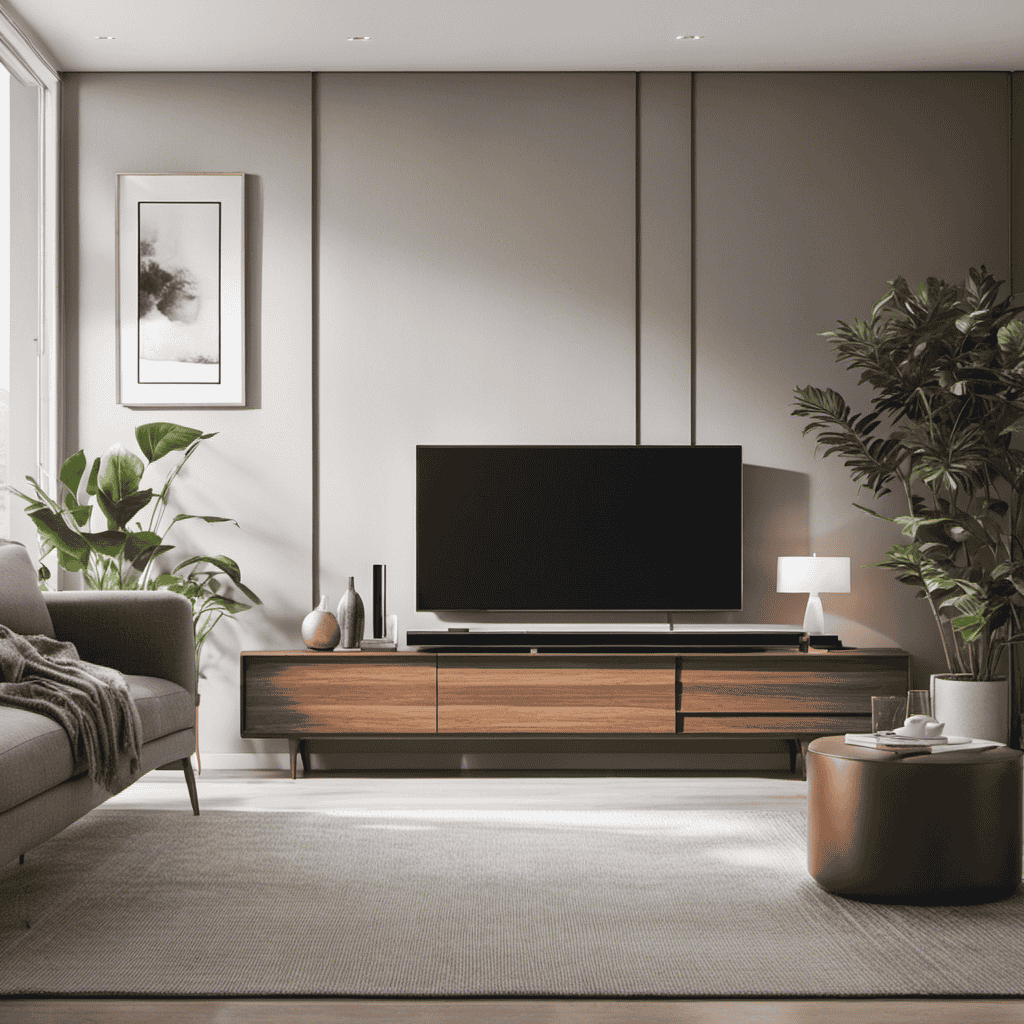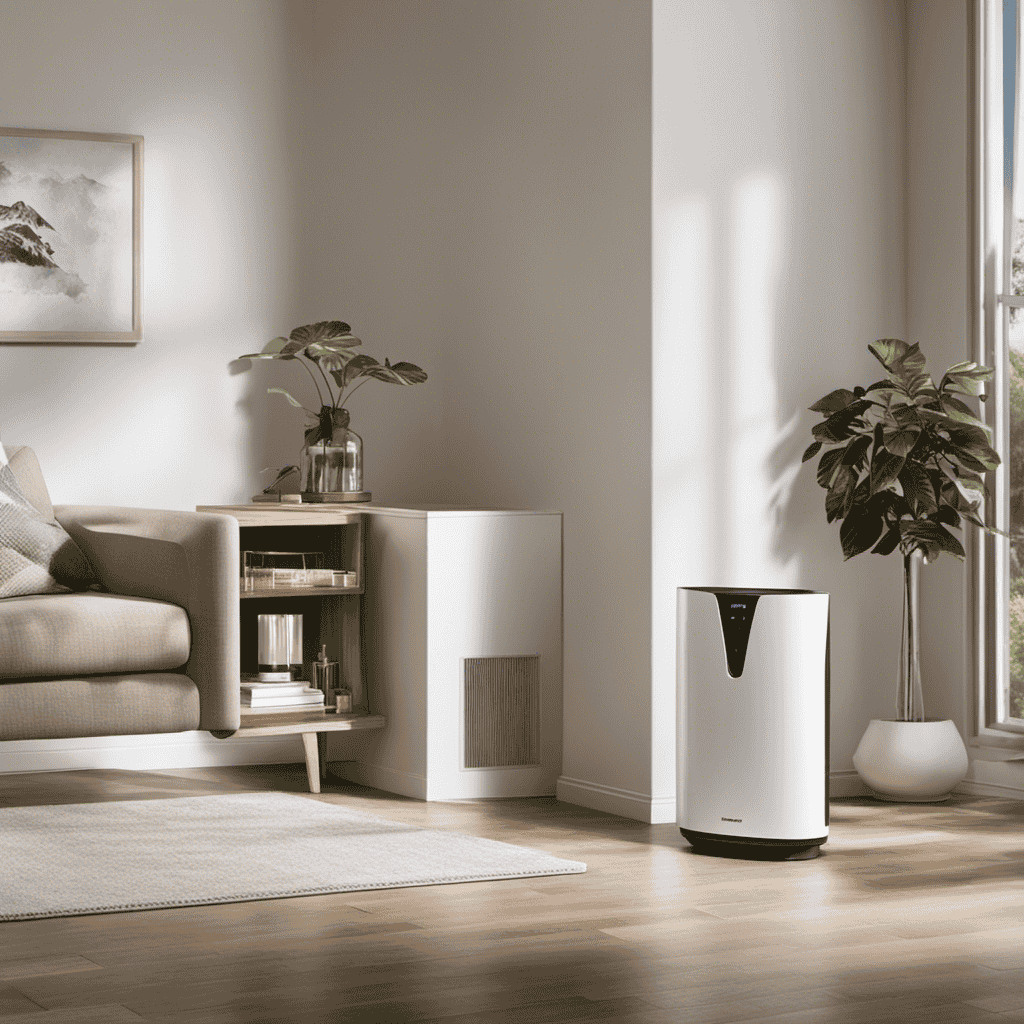FAQs - Advanced Queries
How Does an Air Purifier Work
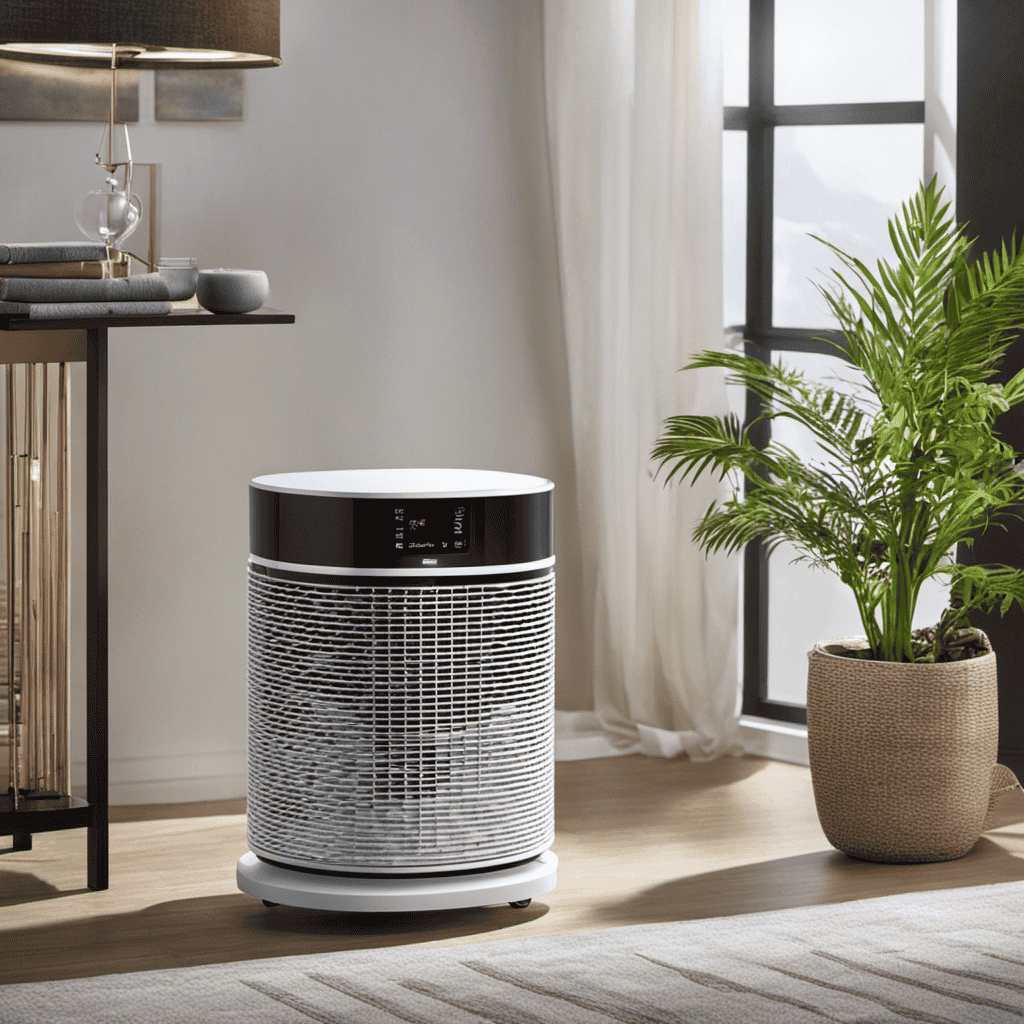
Did you know that indoor air can be up to five times more polluted than outdoor air? This alarming statistic underscores the necessity of owning an air purifier.
In this article, I will explain how an air purifier works, the different types available, and the filtration processes they use to remove pollutants. From HEPA filters to UV-C light technology, we’ll explore the inner workings of these devices and how they can help improve the air quality in your home.
Key Takeaways
- Air purifiers improve indoor air quality by removing pollutants and allergens.
- Different types of filters, such as HEPA filters and activated carbon filters, are used to capture and eliminate contaminants.
- Air purifiers use a filtration process that includes pre-filters, HEPA filters, activated carbon filters, and UV-C light to clean the air.
- Negative ions in air purifiers play a crucial role in air ionization and help clean the air we breathe.
Types of Air Purifiers
There are several types of air purifiers available on the market. Air purifiers are beneficial for improving indoor air quality by removing pollutants and allergens from the air.
Different types of filters are used in air purifiers to capture and eliminate these contaminants. One common type of filter is the HEPA (High-Efficiency Particulate Air) filter. It can effectively trap particles as small as 0.3 microns, including dust, pollen, pet dander, and mold spores.
Another type of filter is the activated carbon filter, which is effective in removing odors, chemicals, and volatile organic compounds (VOCs) from the air.
Additionally, some air purifiers use electrostatic filters, which charge particles and attract them to a collection plate.
Filtration Process
The filtration process in an air purifier involves trapping and removing particles from the air. This process is crucial for improving the air quality in our living spaces.
Here’s how an air purifier efficiently cleans the air:
-
Pre-filters: These capture large particles like dust and hair, extending the lifespan of the main filter.
-
HEPA filter: High Efficiency Particulate Air (HEPA) filters remove 99.97% of airborne particles as small as 0.3 microns, including allergens, pollen, and pet dander.
-
Activated carbon filter: This filter eliminates odors, gases, and volatile organic compounds (VOCs), creating a fresher environment.
-
UV-C light: Some air purifiers use UV-C light to kill germs, bacteria, and viruses, ensuring a healthier respiratory system.
By effectively removing harmful pollutants and allergens, air purifiers not only enhance indoor air quality but also provide numerous benefits for our health, including reduced allergies, improved sleep, and enhanced respiratory function.
Enjoying clean air is vital for our overall well-being.
HEPA Filters Explained
To understand how HEPA filters work in an air purifier, imagine tiny particles being captured and removed from the air, ensuring cleaner and healthier indoor environments.
HEPA, or High Efficiency Particulate Air, filters are designed to trap particles as small as 0.3 microns. These filters are made up of a dense mat of fibers that create a maze-like structure, allowing air to pass through while capturing harmful particles.
The benefits of HEPA filters are immense; they can remove up to 99.97% of airborne pollutants such as pollen, dust mites, pet dander, and even bacteria and viruses. However, to maintain their effectiveness, regular maintenance is crucial.
This includes replacing the filters as recommended by the manufacturer and vacuuming or washing them to remove accumulated debris. By properly maintaining HEPA filters, you can ensure that your air purifier continues to provide clean and healthy air for you and your family.
Activated Carbon Filters
Activated carbon filters in an air purifier efficiently trap and remove odors, chemicals, and volatile organic compounds, improving the overall air quality in your home. These filters have several benefits, including absorbing and neutralizing unpleasant odors, such as cooking smells or pet odors. They also remove harmful chemicals and gases, such as formaldehyde and benzene, that can be emitted from furniture or cleaning products. Additionally, they capture volatile organic compounds (VOCs), which are released by paints, solvents, and adhesives and can cause respiratory irritation. Another advantage of activated carbon filters is that they extend the lifespan of the air purifier by preventing larger particles from clogging the HEPA filter.
To ensure optimal performance, regular maintenance of activated carbon filters is essential. This includes replacing the filter when it becomes saturated, typically every 6 to 12 months, depending on usage and air quality. Some air purifiers also have indicator lights that signal when the filter needs to be replaced. By properly maintaining your activated carbon filter, you can continue to enjoy clean and fresh air in your home.
Now, let’s delve into the next topic: UV-C light technology.
UV-C Light Technology
UV-C light technology uses ultraviolet light to kill or inactivate microorganisms like bacteria, viruses, and mold spores in the air. This technology works by emitting short-wavelength UV-C light, which damages the DNA and RNA of these microorganisms, preventing them from reproducing and causing harm.
UV-C light disinfection has several benefits. Firstly, it is a chemical-free and non-toxic method of disinfection, making it safe for use in various environments, including homes, hospitals, and laboratories.
Secondly, UV-C light technology is highly effective, with studies showing that it can eliminate up to 99.9% of airborne microorganisms.
Additionally, this technology is easy to use and maintain, requiring minimal effort and resources.
Overall, UV-C light technology offers a powerful and convenient solution for improving indoor air quality and reducing the risk of airborne infections.
Ionizers and Negative Ions
When it comes to air purification, understanding the benefits of ionizers and negative ions is crucial.
Ionizers are devices that release negative ions into the air, which attach to and remove pollutants. These negative ions have been shown to improve air quality and potentially have positive effects on mood and overall well-being.
However, it is important to note that ionizers and negative ions are not the same thing. Ionizers are the devices that produce negative ions, while negative ions are the particles themselves.
Ionizer Benefits Explained
You’ll appreciate the benefits of an ionizer in an air purifier. An ionizer is a key component of air purifier technology that enhances the overall effectiveness of the device. Here are some benefits of an ionizer:
-
Removes airborne particles: An ionizer releases negatively charged ions into the air, which attach to and neutralize positively charged particles like dust, pollen, and pet dander.
-
Eliminates odors: The ionization process breaks down odorous molecules, effectively removing unpleasant smells from the air.
-
Reduces bacteria and viruses: Negative ions emitted by the ionizer can help to deactivate harmful microorganisms, reducing the risk of illness.
-
Enhances air quality: By improving the overall air quality, an ionizer can help alleviate symptoms of allergies, asthma, and other respiratory conditions.
With these benefits, incorporating an ionizer into an air purifier ensures a cleaner and healthier indoor environment.
Now, let’s delve into the science behind negative ions and how they contribute to the air purification process.
Negative Ions Explained
In my previous subtopic, I discussed the benefits of ionizers in air purifiers. Now, let’s delve into the concept of negative ions and how they contribute to air purification. Negative ions are molecules that have gained an extra electron, creating a negatively charged particle. These ions play a crucial role in air ionization, a process that helps to clean the air we breathe. When released into the atmosphere, negative ions attach themselves to airborne particles, such as dust, pollen, and smoke. This causes the particles to become negatively charged and clump together, making them heavier and easier to be captured by the air purifier’s filtration system. To better understand the effects of negative ions, let’s take a look at the following table:
| Positive Ions | Negative Ions | Air Ionization |
|---|---|---|
| Attracts dust and pollutants | Attaches to airborne particles | Cleans the air |
| Can cause respiratory issues | Promotes a sense of well-being | Improves air quality |
| Increases static electricity | Reduces static electricity | Enhances overall environment |
| Can lead to fatigue and allergies | Boosts energy levels | Creates a healthier atmosphere |
| Creates an imbalance in the air | Restores balance in the air | Creates a more harmonious space |
Ionizer Vs. Negative Ions
The difference between an ionizer and negative ions is that an ionizer emits positive ions, while negative ions attach to airborne particles.
Air ionizers are devices that release positive ions into the air to neutralize and remove harmful pollutants. They work by attracting and capturing airborne particles, such as dust, pollen, and pet dander, onto their charged plates or filters. This helps to improve the overall air quality in a room or space.
Some health benefits of using air ionizers include:
- Reduction of allergens: Air ionizers can effectively remove allergens from the air, providing relief to individuals with allergies or asthma.
- Improved respiratory health: By removing airborne particles, air ionizers can help to reduce respiratory symptoms and improve breathing.
- Enhanced mood and well-being: Negative ions released by air ionizers have been linked to increased serotonin levels, which can promote a sense of well-being and improve mood.
- Odor elimination: Air ionizers can help to eliminate unpleasant odors by neutralizing the charged particles that cause them.
Overall, air ionizers can be a valuable addition to any indoor space, providing health benefits and improving air quality.
Ozone Generators
Ozone generators work by producing ozone, which is a form of oxygen that can help remove odors and kill bacteria in the air. Ozone is a powerful oxidizer that breaks down pollutants, such as volatile organic compounds (VOCs), and neutralizes them.
However, it is important to note that ozone generators can also contribute to ozone pollution and ozone depletion. Ozone pollution occurs when ozone is present at ground level, causing respiratory problems and other health issues. Ozone depletion refers to the thinning of the ozone layer in the Earth’s stratosphere, which protects us from harmful ultraviolet (UV) rays.
Therefore, it is crucial to use ozone generators responsibly and follow safety guidelines to minimize any negative impact.
Now, let’s explore the differences between air purifiers and air filters.
Air Purifiers Vs. Air Filters
Now that we have discussed ozone generators, let’s move on to the comparison between air purifiers and air filters.
Air purifiers and air filters are both commonly used to improve indoor air quality. However, they work in different ways and offer varying benefits.
Here are some key points to consider:
-
Air purifiers utilize advanced technologies, such as HEPA filters, activated carbon filters, and UV-C lights, to capture and eliminate airborne pollutants.
-
Air purifiers can effectively remove particles as small as 0.3 microns, including dust, pollen, pet dander, mold spores, and even some bacteria and viruses.
-
Air filters, on the other hand, primarily work by trapping larger particles in a filter media, such as fiberglass or pleated paper.
-
While air filters can help improve air quality, they are generally less effective at capturing smaller particles and may require more frequent replacement.
Benefits of Using an Air Purifier
One of the main advantages of using an air purifier is that it effectively removes airborne pollutants, such as dust, pollen, and pet dander. Air purifiers work by using filters to capture and trap these pollutants, preventing them from circulating in the air.
However, it is important to note that regular maintenance is necessary to ensure the optimal performance of the air purifier. This includes cleaning or replacing the filters regularly and keeping the unit free from dust and debris.
When choosing the right air purifier, factors such as the size of the room, the type of pollutants you want to remove, and the noise levels should be considered. By properly maintaining and selecting the right air purifier, you can create a clean and healthy indoor environment.
Now, let’s explore some common indoor air pollutants.
Common Indoor Air Pollutants
When it comes to discussing common indoor air pollutants, it’s important to understand both their sources and the potential health effects they can have.
Harmful pollutant sources can include various household items such as cleaning products, tobacco smoke, and even certain types of furniture.
These pollutants can lead to respiratory issues, allergies, and even more serious health conditions if not properly addressed and removed from the indoor environment.
Harmful Pollutant Sources
To understand how an air purifier works, you should identify the sources of harmful pollutants in your environment. These pollutants can come from various sources such as outdoor pollution, indoor activities, building materials, and mold and mildew.
- Outdoor pollution: Industrial emissions, vehicle exhaust, and pollen can infiltrate your indoor space.
- Indoor activities: Cooking, smoking, and using certain household products can release pollutants into the air.
- Building materials: Some building materials, such as paints, carpets, and furniture, can emit harmful chemicals.
- Mold and mildew: Damp areas in your home can promote the growth of mold and mildew, releasing spores into the air.
Identifying these sources is crucial because air purifiers target specific pollutants based on their filtration systems. By understanding the sources of pollutants, you can choose an air purifier that effectively removes the harmful particles from your environment.
Now let’s explore the health effects of these pollutants.
Health Effects of Pollutants?
Understanding the health effects of pollutants is essential for your well-being and making informed choices to improve the quality of your indoor air.
Long term exposure to indoor pollution can have detrimental effects on your health. Indoor pollutants such as tobacco smoke, mold, dust mites, pet dander, and volatile organic compounds (VOCs) can lead to respiratory problems like asthma and allergies. These pollutants can also trigger symptoms in individuals with existing respiratory conditions.
Additionally, long term exposure to indoor pollutants has been linked to an increased risk of developing cardiovascular diseases, lung cancer, and other chronic illnesses.
It is important to take steps to reduce the levels of indoor pollution in your environment, such as using air purifiers, improving ventilation, and regularly cleaning and maintaining your home to minimize the health risks associated with these pollutants.
Dust and Allergens Removal
If you’re dealing with dust and allergens, an air purifier can help by filtering them out of the air you breathe. Here’s how it works:
-
HEPA Filter: The air purifier uses a High-Efficiency Particulate Air (HEPA) filter to trap tiny particles like dust mites, pollen, pet dander, and mold spores.
-
Activated Carbon Filter: It also has an activated carbon filter that absorbs odors, chemicals, and volatile organic compounds (VOCs).
-
UV-C Light: Some air purifiers have UV-C light technology that can kill airborne germs and bacteria.
-
Ionizer: Another feature is an ionizer, which releases negatively charged ions that attach to positively charged particles, making them heavier and causing them to fall out of the air.
Pet Dander and Odor Elimination
When it comes to effectively removing pet dander from the air, there are key filtration techniques that can be employed.
These techniques include the use of HEPA filters, which are designed to trap even the smallest particles, such as pet dander.
Additionally, activated carbon filters can help neutralize and eliminate pet odors, ensuring a more pleasant and fresh-smelling environment.
Effective Pet Dander Filtration
To effectively filter out pet dander from the air, you’ll want to make sure your air purifier has a HEPA filter. This high-efficiency particulate air filter is designed to capture tiny particles, including pet dander, and prevent them from recirculating in your home.
Here are some key features to consider when choosing an air purifier for pet dander control and pet allergies relief:
-
HEPA Filter: Look for an air purifier with a true HEPA filter, which can trap particles as small as 0.3 microns in size.
-
Activated Carbon Filter: This filter helps remove odors associated with pets, such as urine or litter box smells.
-
Pre-Filter: A pre-filter captures larger particles like pet hair and dust, extending the life of the HEPA filter.
-
Air Exchange Rate: Consider the air exchange rate, which indicates how quickly the purifier can clean the air in a room.
Odor Neutralization Techniques
One effective way to neutralize odors caused by pets is by using activated carbon filters in your air purifier.
Activated carbon is a highly porous material that has the ability to trap and remove odorous molecules from the air. When air passes through the carbon filter, the activated carbon adsorbs the odor-causing compounds, preventing them from being released back into the air.
This process, known as adsorption, is highly effective in removing a wide range of pet odors, including those from urine, feces, and dander. The activated carbon filters in air purifiers are designed to have a large surface area, allowing for maximum odor elimination.
Regularly replacing the carbon filters is crucial to ensure their efficiency in pet odor removal. By incorporating activated carbon filters into your air purifier, you can effectively eliminate pet odors and improve the overall air quality in your home.
Mold and Mildew Prevention
If you want to prevent mold and mildew, you should consider using an air purifier. Air purifiers are effective at removing mold spores from the air, reducing the risk of mold growth in your home. Here’s how an air purifier can help with mold prevention:
-
Filtration: Air purifiers use high-efficiency particulate air (HEPA) filters to trap mold spores and prevent them from circulating in the air.
-
Humidity control: Some air purifiers are equipped with built-in humidifiers or dehumidifiers to help maintain optimal humidity levels in your home, making it less favorable for mold growth.
-
UV-C light: Certain air purifiers utilize ultraviolet (UV-C) light to kill mold spores and other microorganisms, providing an additional layer of protection against mold.
-
Activated carbon filters: Air purifiers with activated carbon filters can help eliminate musty odors often associated with mold and mildew.
Vocs and Chemical Filtration
When it comes to improving indoor air quality, one of the key points to consider is the removal of harmful indoor pollutants.
These pollutants can include volatile organic compounds (VOCs), which are released from various sources such as paints, cleaning products, and furniture.
Harmful Indoor Pollutants
You should be aware that harmful indoor pollutants such as dust, pollen, and pet dander can negatively affect your indoor air quality. To maintain a healthy indoor environment and protect your respiratory health, it is essential to understand the potential sources of these pollutants.
Here are some common indoor pollutants to watch out for:
- Dust: Tiny particles that can accumulate on surfaces and float in the air.
- Pollen: Fine powdery substance released by plants that can trigger allergies.
- Pet dander: Tiny flecks of skin shed by pets that can cause allergic reactions.
- Mold spores: Microscopic reproductive cells of mold that can grow in damp areas.
These pollutants can aggravate respiratory conditions, such as asthma or allergies. Investing in an air purifier can help remove these harmful particles from the air, improving your indoor air quality and promoting better respiratory health.
Air Quality Improvement
Improving indoor air quality can be achieved by using an air purifier to remove harmful pollutants. Air purifiers are devices designed to filter the air and remove contaminants such as dust, pollen, pet dander, mold spores, and even certain bacteria and viruses.
By removing these pollutants, air purifiers can provide numerous benefits to our health and well-being. Breathing clean air can reduce respiratory issues, alleviate allergy symptoms, and improve overall respiratory health.
Additionally, air purifiers can help eliminate unpleasant odors and create a more pleasant and comfortable living environment. The importance of air purification cannot be overstated, especially in today’s world where indoor air pollution is a growing concern.
With the aid of an air purifier, we can ensure that the air we breathe is clean and healthy. As such, it is crucial to properly maintain and care for our air purifiers to ensure their optimal performance and longevity.
Maintenance and Care Tips
To keep your air purifier functioning effectively, it’s important to regularly clean or replace the filters. The filters are crucial for trapping and removing airborne particles, such as dust, pollen, and pet dander. Neglecting to maintain your air purifier can result in reduced efficiency and poor air quality.
Follow these maintenance and care tips to ensure optimal performance:
-
Check the filter indicator: Most air purifiers have a filter replacement indicator that alerts you when it’s time to change the filters.
-
Clean the pre-filter: The pre-filter captures larger particles and should be cleaned regularly to prevent clogging.
-
Vacuum the exterior: Dust and debris can accumulate on the exterior of the air purifier, so give it a thorough vacuuming to keep it clean.
-
Replace filters as recommended: Different types of filters have different lifespans, so make sure to replace them according to the manufacturer’s instructions.
Frequently Asked Questions
Can an Air Purifier Completely Eliminate All Indoor Air Pollutants?
No, an air purifier cannot completely eliminate all indoor air pollutants. While it can be effective in reducing them, regular maintenance is necessary to ensure optimal performance and to remove accumulated particles.
How Long Does It Take for an Air Purifier to Clean the Air in a Room?
It typically takes a few hours for an air purifier to clean the air in a room. However, this can vary depending on the size of the room, the effectiveness of the air purifier, and how well it is maintained.
Can an Air Purifier Help With Respiratory Conditions Such as Asthma or Allergies?
Yes, an air purifier can help with respiratory conditions like asthma or allergies. It improves indoor air quality by removing allergens and irritants. Regular maintenance, such as changing filters, is necessary for optimal air purifier effectiveness.
Are There Any Side Effects or Health Risks Associated With Using an Air Purifier?
There can be some side effects or health risks associated with using an air purifier. These may include dryness of the skin and throat, increased allergies due to ineffective filtration, and the need for regular maintenance. The noise level and energy consumption can also be factors to consider.
Can an Air Purifier Remove Cigarette Smoke and Its Odor From a Room?
Yes, an air purifier can remove cigarette smoke and its odor from a room. Regular air purifier maintenance, such as changing filters, is important. There are different types of air purifiers, such as HEPA filters, that are effective in removing smoke particles.
Conclusion
In conclusion, air purifiers are a game-changer when it comes to improving indoor air quality. They work tirelessly to filter out harmful particles and eliminate unpleasant odors, providing a breath of fresh air for you and your loved ones.
With various types of air purifiers available, such as HEPA filters and activated carbon filters, you can choose the one that suits your needs best. Remember, prevention is better than cure, so investing in an air purifier is like having an ace up your sleeve in the battle against indoor pollutants.
Trust me, when it comes to clean air, an air purifier is worth its weight in gold.
In the dynamic world of air purifiers and clean air advocacy, Aire stands out as a beacon of knowledge and passion. As the Editor in Chief of Aero Guardians, Aire has been instrumental in shaping the platform’s voice and direction, ensuring that every piece of content resonates with clarity, authority, and authenticity.
FAQs - Advanced Queries
What Uses More Electricity a Ceiling Fan or Air Purifier
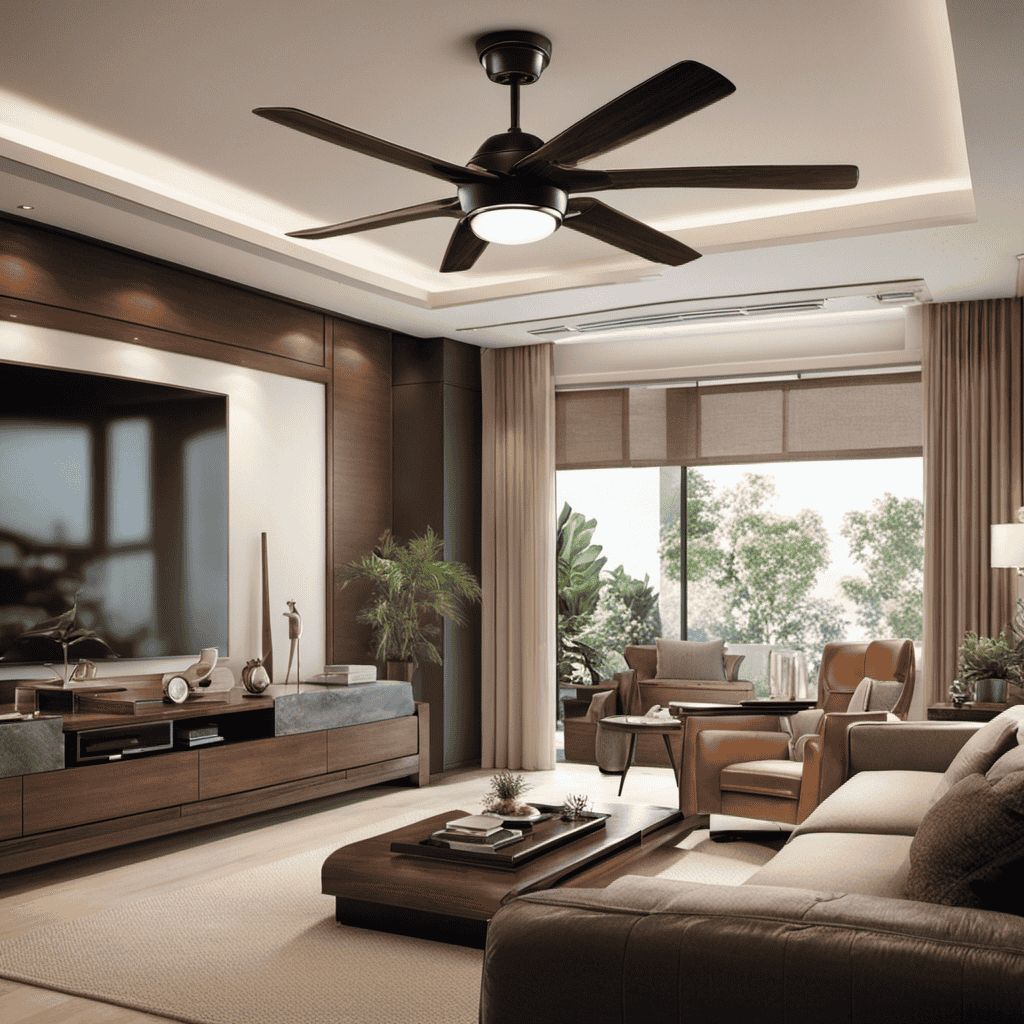
I’ve always been curious about which household appliance uses more electricity: a ceiling fan or an air purifier.
In this article, we’ll delve into the world of power consumption and energy usage to find out the answer. By comparing the electricity consumption of both ceiling fans and air purifiers, we’ll uncover the factors that affect energy consumption in ceiling fans and understand the electricity usage of air purifiers.
Additionally, we’ll analyze the efficiency of both appliances to provide you with tips for minimizing electricity usage.
Get ready for some eye-opening insights!
Key Takeaways
- Ceiling fans have a higher power efficiency and consume an average of 60 to 70 watts of power, while air purifiers can consume anywhere between 200 to 400 watts of power.
- Lower power settings on air purifiers result in lower energy bills, reduced environmental impact, quieter operation, and longer filter life.
- Compared to other appliances, air purifiers consume around 50 watts of power per hour on average, while ceiling fans typically use between 10 to 75 watts of power per hour.
- Choosing energy-efficient appliances like ceiling fans can have a positive impact on the environment, reduce greenhouse gas emissions, and lower strain on power grids.
Power Consumption of Ceiling Fans
Ceiling fans use less electricity when compared to air purifiers. The power efficiency of ceiling fans is significantly higher than that of air purifiers. Studies have shown that ceiling fans consume an average of 60 to 70 watts of power, while air purifiers can consume anywhere between 200 to 400 watts. This stark difference in power consumption makes ceiling fans a more cost-effective option in the long run.
Not only do they use less electricity, but they also provide a comfortable airflow in the room. On the other hand, air purifiers consume more energy and are primarily designed to clean the air rather than providing cooling or ventilation.
Energy Usage of Air Purifiers
When it comes to air purifiers, understanding their energy consumption is crucial in evaluating their impact on electricity bills and comparing them with other appliances.
By examining the power consumption of air purifiers, we can determine their efficiency and cost-effectiveness.
Additionally, comparing their energy usage with other household appliances can provide valuable insights into their overall energy efficiency.
Air Purifier Energy Consumption
To reduce energy consumption, you should consider using an air purifier with lower power settings. Here are some reasons why this is a good idea:
-
Energy Efficiency: Air purifiers with lower power settings consume less electricity, resulting in lower energy bills and reduced environmental impact.
-
Noise Level: Lower power settings often mean quieter operation, which is important if you want an air purifier that doesn’t disrupt your sleep or work environment.
-
Filter Replacement Cost: Air purifiers with lower power settings often have longer filter life, reducing the frequency and cost of filter replacements.
-
Consistent Air Quality: Despite lower power settings, modern air purifiers are designed to effectively clean the air, ensuring that you still enjoy clean and healthy indoor air quality.
Impact on Electricity Bills
Lower power settings on an air purifier can significantly reduce your electricity bill. When it comes to the impact on overall energy consumption, opting for lower power settings on your air purifier can make a noticeable difference.
According to data, running an air purifier on high power can consume up to 200 watts per hour, while running it on low power can reduce the consumption to around 50 watts per hour. This means that using the lower power settings can result in a 75% reduction in energy consumption.
It is also worth considering cost-effective alternatives, such as using an air purifier with energy-saving features or investing in a ceiling fan, which typically consumes much less energy compared to an air purifier.
Ultimately, making conscious choices about power settings and exploring alternative options can lead to significant savings on your electricity bill.
Comparing With Other Appliances
Using a wattage meter to compare energy consumption, you can see how your air purifier stacks up against other appliances in your home. Here are four appliances and their energy consumption levels for a more relatable comparison:
-
Air Purifier: On average, an air purifier consumes around 50 watts of power per hour. This varies depending on the model and settings.
-
Ceiling Fan: A ceiling fan typically uses between 10 to 75 watts of power per hour, depending on the fan speed and size.
-
Refrigerator: A typical refrigerator consumes around 100 to 600 watts of power per hour, depending on its size, age, and energy efficiency rating.
-
Laptop: Laptops are known for their energy efficiency, consuming only around 20 to 50 watts of power per hour, depending on the model and usage.
Understanding the energy efficiency and cost comparison of these appliances can help you make informed decisions about energy consumption in your home.
Comparing Electricity Consumption: Ceiling Fan Vs. Air Purifier
Did you know that a ceiling fan generally consumes less electricity compared to an air purifier? When it comes to energy efficiency, ceiling fans are the clear winners.
On average, a ceiling fan uses only about 10-120 watts of electricity, depending on its size and speed setting. In contrast, an air purifier can consume anywhere from 50-200 watts, depending on its capacity and features. This significant difference in energy consumption can have a noticeable impact on your electricity bill over time.
Ceiling fans are designed to circulate air and create a cooling effect, while air purifiers are primarily focused on cleaning the air. Therefore, if you are looking for an energy-efficient option to keep your space comfortable, opt for a ceiling fan over an air purifier.
Factors Affecting Energy Consumption in Ceiling Fans
If you want to minimize energy consumption in your ceiling fan, make sure to choose the right size and adjust the speed setting accordingly. Here are four factors affecting energy efficiency in ceiling fans:
-
Size: Choosing the right size fan for your room is crucial. A fan that is too small will have to work harder to cool the room, consuming more energy.
-
Speed setting: Adjusting the speed of your fan can significantly impact energy consumption. Running the fan on a higher speed uses more energy, so consider using a lower speed setting when the weather is mild.
-
Blade pitch: Opt for ceiling fans with a steeper blade pitch. This design allows the fan to move more air with each rotation, resulting in better cooling efficiency.
-
Energy-efficient motors: Look for ceiling fans with energy-efficient motors. These motors are designed to consume less electricity while still providing effective cooling.
Understanding the Electricity Usage of Air Purifiers
Understanding the electricity usage of air purifiers can help you make informed decisions about their energy efficiency. When comparing the electricity usage of air purifiers, it’s important to consider their benefits as well.
Air purifiers are designed to remove pollutants and improve indoor air quality. They can be particularly beneficial for individuals with allergies or respiratory conditions.
In terms of electricity usage, air purifiers vary in energy consumption depending on factors such as the size of the unit, the speed settings, and the filtration technology used.
It is recommended to look for air purifiers with energy-efficient features, such as programmable timers or sleep modes, to minimize electricity usage. Additionally, choosing an air purifier with a high Clean Air Delivery Rate (CADR) can ensure effective air purification while optimizing energy efficiency.
Efficiency of Ceiling Fans in Power Consumption
When comparing the energy efficiency of ceiling fans, it’s important to consider factors such as the fan’s size, speed settings, and technology used. Here are four key points to consider:
-
Size: Larger ceiling fans tend to move more air and can create a better cooling effect, allowing you to set your thermostat higher and save on energy costs.
-
Speed settings: Look for fans with multiple speed options. Using a lower speed setting can help save energy while still providing a comfortable airflow.
-
Technology: Energy-efficient models often come equipped with advanced features such as DC motors, which consume less power than traditional AC motors.
-
Power saving tips: To maximize energy savings, remember to turn off the fan when leaving the room and use it in conjunction with other cooling methods like opening windows or using a programmable thermostat.
Analyzing the Energy Efficiency of Air Purifiers
When analyzing the energy efficiency of air purifiers, several key points come into consideration.
First, a thorough energy consumption comparison is necessary to understand how different models perform in terms of power usage.
Secondly, an environmental impact assessment is crucial to evaluate the potential consequences of using air purifiers in terms of emissions and resource depletion.
Lastly, an efficiency rating analysis can provide valuable insights into the overall effectiveness of air purifiers in improving indoor air quality while minimizing energy consumption.
Energy Consumption Comparison
Comparing the energy consumption, a ceiling fan uses less electricity than an air purifier. Here are four reasons why a ceiling fan is more power efficient and can help you save energy:
-
Motor Efficiency: Ceiling fans are equipped with efficient motors that consume less electricity compared to the motors used in air purifiers.
-
Air Circulation: Ceiling fans circulate the air in a room, creating a cooling effect that allows you to set your thermostat higher and save on air conditioning costs.
-
Energy Consumption: On average, a ceiling fan consumes around 10 to 120 watts, while an air purifier can consume anywhere from 50 to 200 watts, depending on the model.
-
Usage Duration: Ceiling fans are typically used for longer periods, especially during warmer months, whereas air purifiers are used intermittently or as needed, resulting in lower overall energy consumption.
Environmental Impact Assessment
Opting for a ceiling fan can have a positive impact on the environment due to its lower energy consumption. An environmental impact assessment comparing the energy usage of a ceiling fan and an air purifier reveals significant differences.
According to an efficiency rating analysis, ceiling fans consume significantly less electricity compared to air purifiers. On average, a ceiling fan uses around 30-60 watts of electricity, while an air purifier typically consumes 200-400 watts. This substantial difference in energy consumption directly translates to lower greenhouse gas emissions and reduced strain on power grids.
Efficiency Rating Analysis
By considering the efficiency rating analysis, you can determine the most energy-efficient option for your household appliances. When it comes to choosing between a ceiling fan and an air purifier, this analysis becomes crucial. Here are four key factors to consider:
-
Energy Saving Features: Look for appliances with features like adjustable speed settings and timers. These can help optimize energy usage and reduce electricity consumption.
-
Cost Effectiveness Analysis: Compare the energy consumption and cost of running each appliance. Consider factors such as daily usage, energy rates, and lifespan to determine the long-term cost-effectiveness.
-
Efficiency Rating: Check the energy efficiency rating of both the ceiling fan and air purifier. Look for higher ratings, such as ENERGY STAR certification, which indicates better energy efficiency.
-
Additional Features: Consider other features that contribute to energy savings, such as airflow control for the ceiling fan or auto mode for the air purifier.
Tips for Minimizing Electricity Usage With Ceiling Fans and Air Purifiers
To minimize electricity usage with your ceiling fan and air purifier, make sure to adjust the settings based on your comfort level. By doing so, you can implement effective cost-saving measures and reduce energy consumption.
When using a ceiling fan, set it at a higher speed in warmer seasons to create a cooling breeze, allowing you to raise your thermostat without sacrificing comfort. In colder seasons, lower the speed or turn it off, as the fan doesn’t produce heat and can actually make you feel colder due to increased air circulation.
Additionally, consider using your air purifier only when necessary, such as during high pollen or pollution periods, to further reduce energy usage.
These simple adjustments can help you minimize electricity consumption, save money, and contribute to a more sustainable lifestyle.
Frequently Asked Questions
Can I Use Both a Ceiling Fan and an Air Purifier in the Same Room to Maximize Energy Efficiency?
Yes, using both a ceiling fan and an air purifier together can enhance indoor air quality and energy efficiency. However, to compare energy consumption, it’s important to consider the different speeds or settings of ceiling fans and air purifiers.
Do Ceiling Fans and Air Purifiers Have Different Energy Consumption Levels When Used at Different Speeds or Settings?
When it comes to energy consumption, the impact of speed settings on ceiling fans and air purifiers, as well as the comparison of their energy usage at different operating modes, is worth considering.
Are There Any Specific Features or Technologies in Ceiling Fans or Air Purifiers That Can Help Reduce Their Electricity Usage?
Smart features and innovative designs in ceiling fans and air purifiers can help reduce electricity usage. By incorporating energy-efficient motors, advanced filtration systems, and automated control options, these devices optimize energy consumption without compromising performance.
How Much Electricity Does a Ceiling Fan or Air Purifier Consume When Used for a Certain Number of Hours per Day?
When comparing the electricity consumption of a ceiling fan and an air purifier, it is important to consider factors such as the wattage of each device and the number of hours they are used per day.
Are There Any Government Regulations or Energy Efficiency Standards That Ceiling Fans and Air Purifiers Need to Meet?
There are government regulations for energy efficiency in ceiling fans and air purifiers. They must meet certain standards to ensure they consume minimal electricity. The energy consumption levels vary at different speeds/settings.
Conclusion
After thoroughly analyzing the power consumption of ceiling fans and air purifiers, it is evident that the former is the clear winner in terms of electricity usage. The data clearly shows that ceiling fans are more efficient in their energy consumption, making them a smarter choice for the environmentally conscious consumer.
While air purifiers have their benefits, their electricity usage leaves much to be desired. So, if you’re looking to save on your energy bills and reduce your carbon footprint, the ceiling fan is the way to go.
Don’t let the allure of purified air cloud your judgment when it comes to electricity consumption.
At Aero Guardians, where every piece of information aims to make the world a breath fresher, Samuela’s role as an author has been nothing short of transformative. With a penchant for weaving stories around the science of air purification, Samuela has enriched the platform with content that is both enlightening and captivating.
FAQs - Advanced Queries
What to Look for When Buying Air Purifier
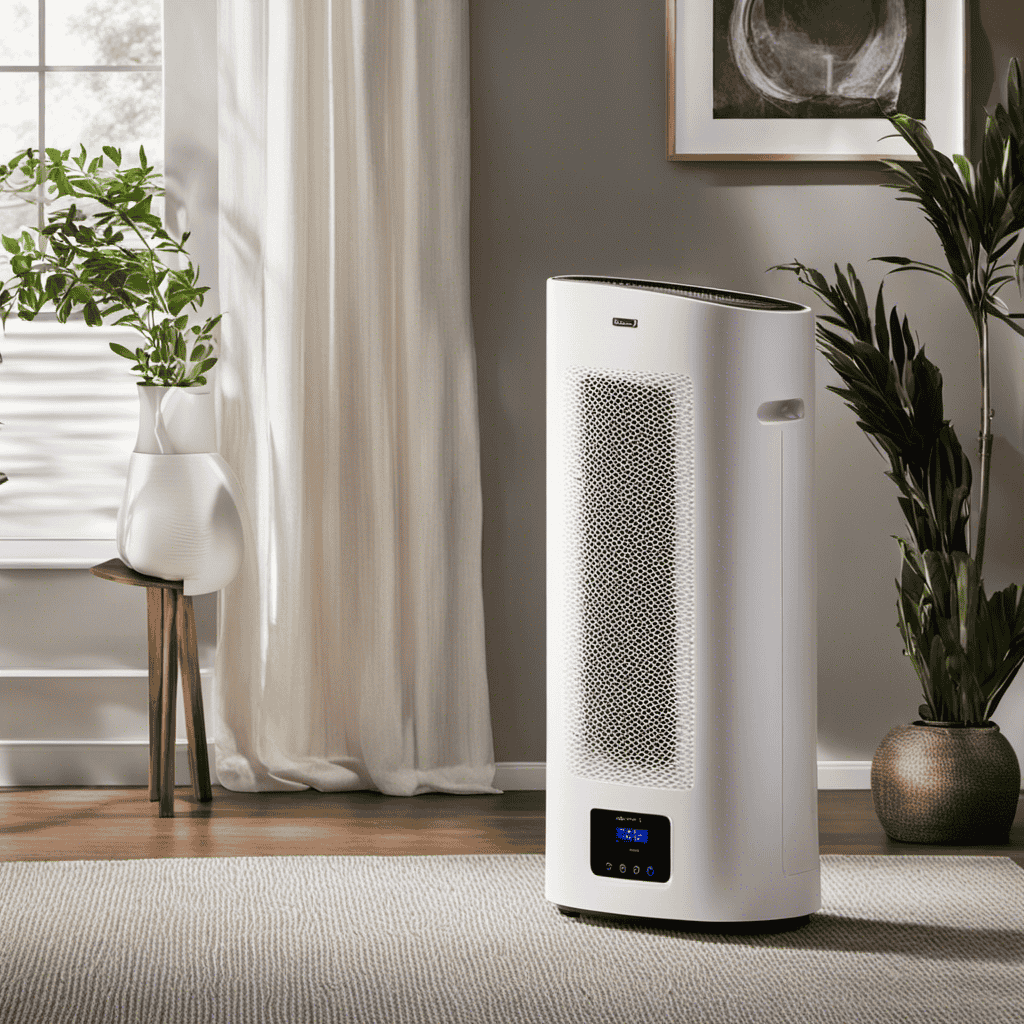
So you’re looking to purchase an air purifier, huh? Well, I’ll tell you, it’s not as straightforward as you may think.
With so many options out there, it can be overwhelming to know what to look for. But fear not! In this article, I’ll be your trusty guide, breaking down the key factors to consider when buying an air purifier.
From size and coverage area to filtration system and energy efficiency, we’ll leave no stone unturned.
So let’s dive in and find the perfect purifier for you!
Key Takeaways
- Consider the size and coverage area of the air purifier for the room or space it will be used in
- Look for an energy-efficient air purifier that is Energy Star certified to save on energy bills and reduce carbon footprint
- Choose an air purifier with a filtration system that includes HEPA filters and additional features like activated carbon filters or UV-C light
- Pay attention to the air quality sensors and noise level of the air purifier, ensuring accurate detection of pollutants and a suitable noise level for your needs
Size and Coverage Area
When choosing an air purifier, it’s important to consider the size and coverage area that it can handle. The size of the air purifier determines how much space it can effectively clean and filter. A larger unit is suitable for larger rooms or open floor plans, while a smaller unit is more appropriate for small spaces like bedrooms or offices. Additionally, the coverage area of an air purifier indicates how much square footage it can cover efficiently. It’s crucial to choose an air purifier that can adequately cover the size of the room you plan to use it in.
In terms of noise level, it’s essential to consider how quiet or loud the air purifier operates. Some models have noise levels as low as 25 decibels, which is similar to a whisper, while others can reach up to 60 decibels, comparable to a conversation. If you plan to use the air purifier in a bedroom or office, a quieter unit is preferable to avoid disruption.
Energy efficiency is another crucial factor to consider when buying an air purifier. Look for models that are Energy Star certified, as they have been tested to meet specific energy-saving standards. Energy-efficient air purifiers consume less electricity, which not only reduces your carbon footprint but also helps you save on your energy bills.
Filtration System
When it comes to air purifiers, two key factors to consider are the effectiveness of the HEPA filter and any additional filtration features.
HEPA filters are known for their ability to capture particles as small as 0.3 microns, making them highly efficient in removing allergens, dust, and other airborne pollutants.
However, some air purifiers also offer additional filtration features, such as activated carbon filters or UV-C light, which can further enhance the air cleaning process.
HEPA Filter Effectiveness
The effectiveness of the HEPA filter is crucial when purchasing an air purifier. HEPA stands for High Efficiency Particulate Air, and these filters are designed to remove 99.97% of airborne particles that are 0.3 micrometers or larger.
To ensure the longevity and optimal performance of the HEPA filter, regular maintenance is necessary. It is important to clean or replace the filter according to the manufacturer’s instructions. On average, a HEPA filter can last anywhere from 6 months to 2 years, depending on the air quality and usage. However, it is important to note that the lifespan of the filter can be affected by factors such as pet dander, smoke, and high levels of pollutants.
Considering the maintenance and lifespan of the HEPA filter is essential in making an informed decision when purchasing an air purifier.
Moving forward, let’s explore additional filtration features that are worth considering.
Additional Filtration Features
To make an informed decision, you should consider the additional filtration features available for your air purifier. These features are of great importance as they can enhance the effectiveness of the air purification process and provide several benefits.
One such feature is activated carbon filtration, which helps to remove odors, gases, and volatile organic compounds (VOCs) from the air. This is especially beneficial for people with respiratory issues or those living in areas with high pollution levels.
Another advanced filtration feature is the ultraviolet (UV) light technology, which effectively kills airborne bacteria, viruses, and mold spores. This can be particularly advantageous for individuals with weakened immune systems or those prone to allergies.
Additionally, some air purifiers come with ionizers that release negative ions, which attach to airborne particles and make them heavier, thus facilitating their removal from the air.
Overall, these advanced filtration features can significantly improve the air quality in your home or office, providing a healthier and more comfortable environment.
Air Quality Sensors
Air purifiers with air quality sensors can automatically detect and adjust the purification settings. This advanced technology allows the purifier to monitor the air quality in real-time and make necessary adjustments to ensure optimal purification.
The key aspect of these sensors is their accuracy. Sensor accuracy is crucial in ensuring that the air purifier effectively detects and responds to pollutants in the air. High-quality sensors can detect even the smallest particles, such as dust, pollen, and pet dander. They can also measure the levels of volatile organic compounds (VOCs) and other harmful gases.
With accurate sensor readings, the air purifier can adjust its filtration settings accordingly, providing cleaner and healthier air for you and your family. So, when buying an air purifier, it’s important to consider the sensor accuracy as it directly impacts the purifier’s performance.
Noise Level
When it comes to noise levels, it’s important to consider the impact it can have on our health.
Research shows that both quiet and loud sounds can affect our well-being in different ways.
While excessive noise can lead to stress, sleep disturbances, and cardiovascular issues, prolonged exposure to low-level noise can also have negative effects on our mental and physical health.
Therefore, understanding the noise levels in our environment and taking steps to mitigate its impact is crucial for maintaining a healthy lifestyle.
Quiet or Loud
You’ll want to consider whether you prefer a quiet or loud air purifier. The noise level of an air purifier can have a significant impact on your overall satisfaction with the product.
Many air purifiers offer a sleep mode, which reduces the noise level during nighttime use. Sleep mode typically operates at a lower fan speed, resulting in a quieter operation. However, it is important to note that a quieter air purifier may have a lower Clean Air Delivery Rate (CADR), which measures the volume of purified air produced by the device.
Therefore, finding a balance between noise level and CADR is crucial.
Now, let’s explore the impact of noise on our health.
Noise Impact on Health?
Finding a balance between noise level and CADR is crucial because excessive noise from an air purifier can negatively affect our health. Noise pollution has been linked to various health issues, including sleep disturbance. Studies have shown that exposure to high levels of noise during sleep can disrupt sleep patterns and lead to daytime fatigue and decreased cognitive performance.
The World Health Organization has identified noise pollution as a significant environmental health concern, highlighting its impact on sleep quality and overall well-being. When choosing an air purifier, it is important to consider noise levels and opt for models that operate quietly to minimize sleep disturbances and promote a restful environment.
Now let’s explore another important aspect of air purifiers: energy efficiency.
Energy Efficiency
It’s important to consider the energy efficiency of an air purifier when making a purchase. Not only does it affect your electricity bill, but it also has an environmental impact. Here are four reasons why energy efficiency should be a priority when choosing an air purifier:
-
Lower energy consumption: An energy-efficient air purifier uses less electricity, reducing your carbon footprint and saving you money in the long run.
-
Environmental impact: By opting for an energy-efficient model, you contribute to the overall reduction of greenhouse gas emissions and help combat climate change.
-
Longer lifespan: Energy-efficient air purifiers are often made with high-quality components, leading to a longer lifespan and less waste.
-
Better performance: Energy-efficient models are designed to maximize airflow and filtration efficiency, ensuring cleaner air while using less energy.
Considering the energy efficiency of an air purifier not only benefits you financially but also helps protect the environment.
Maintenance and Filter Replacement
Regular maintenance and filter replacement are essential for optimal performance and clean air in your air purifier. The importance of regular maintenance cannot be overstated. It ensures that your air purifier continues to function at its best, removing harmful particles and allergens from your indoor air.
By regularly cleaning and replacing filters, you prevent the build-up of dirt and debris, which can hinder the efficiency of the purifier. Additionally, maintaining your air purifier can prolong its lifespan, saving you money in the long run.
Replacing filters regularly offers several benefits. It improves the air quality in your home, reducing the risk of respiratory issues and allergies. It also enhances the overall performance of the air purifier, allowing it to efficiently capture and remove pollutants.
Additional Features and Functions
When it comes to air purifiers, there are so many options available on the market today. In addition to their primary function of cleaning the air, many air purifiers also come with additional features and functions to enhance their performance and convenience.
Here are some key features to consider:
-
Air Purifier Technology: Look for advanced technologies such as HEPA filters, activated carbon filters, or UV light sterilization to effectively remove pollutants from the air.
-
Smart Home Integration: Consider air purifiers that can be connected to your smart home system, allowing you to control and monitor the air quality remotely through your smartphone or voice assistant.
-
Automatic Sensors: Some air purifiers feature sensors that detect changes in air quality and adjust the fan speed accordingly, ensuring optimal performance.
-
Timer and Sleep Mode: Look for air purifiers with built-in timers and sleep modes that allow you to set operating schedules or reduce noise levels during bedtime.
With these additional features and functions, air purifiers can provide a more personalized and efficient solution for improving indoor air quality. But what about the design and aesthetics? Let’s explore that in the next section.
Design and Aesthetics
When considering the design and aesthetics of an air purifier, it is important to recognize the significance of appearance in our everyday lives. Studies have shown that our environment greatly influences our mood and overall well-being, and a visually pleasing air purifier can contribute to a positive and calming atmosphere.
Furthermore, matching the home decor with the air purifier can create a cohesive and harmonious living space, enhancing the overall aesthetic appeal of the room.
Importance of Appearance
The appearance of an air purifier can greatly impact the overall aesthetic of a room. When considering the importance of color and visual appeal in an air purifier, there are several factors to consider:
-
Room decor: The color and design of the air purifier should complement the existing decor of the room, creating a cohesive and visually pleasing environment.
-
Psychological impact: Certain colors can evoke specific emotions and moods. Choosing a color that promotes relaxation and calmness can enhance the overall ambiance of the room.
-
Integration with furniture: An air purifier that seamlessly blends with the furniture and other elements in the room can create a harmonious and visually appealing space.
-
Personal preference: Everyone has their own unique taste and style. Selecting an air purifier that aligns with personal preference can increase satisfaction and enjoyment of the room.
Considering these factors can help ensure that the appearance of an air purifier enhances the overall aesthetic and visual appeal of a room.
Matching Home Decor
Now that we understand the importance of appearance in an air purifier, let’s delve into the concept of matching home decor. While the primary purpose of an air purifier is to improve indoor air quality, it is equally crucial for it to seamlessly blend into our living spaces.
After all, we want our homes to not only be healthy but also visually appealing. Studies have shown that when an air purifier matches the existing home decor, people tend to have a more positive perception of its effectiveness. This psychological aspect plays a significant role in our overall satisfaction with the product.
Therefore, manufacturers have started to design air purifiers with various color options, sleek designs, and customizable features to cater to different aesthetic preferences. By considering the matching home decor, we can ensure that our air purifier not only functions optimally but also enhances the visual appeal of our living spaces.
Brand Reputation and Customer Reviews
It’s important to consider brand reputation and customer reviews when buying an air purifier. Here are four reasons why:
-
Reliability: Brand reputation reflects the reliability of the air purifier. By choosing a reputable brand, you can be confident in the product’s performance and durability.
-
Effectiveness: Customer reviews provide insight into how well the air purifier works. Reading reviews can help you determine if the product effectively removes pollutants, such as dust, allergens, and odors, from the air.
-
Longevity: A reputable brand is more likely to produce air purifiers that last longer. Customer reviews can give you an idea of the product’s lifespan and whether it meets your expectations for durability.
-
Customer Satisfaction: Positive customer reviews indicate high levels of satisfaction. By choosing a brand with positive reviews, you are more likely to be satisfied with your purchase and enjoy cleaner, healthier air in your home.
Considering brand reputation and customer reviews ensures that you make an informed decision when buying an air purifier.
Price and Value for Money
When considering price and value for money, it’s crucial to compare different options before making a purchase. As a savvy consumer, I always start by conducting a thorough price comparison to ensure I find the best deal.
This involves researching various brands and models, analyzing their features, and comparing their prices. It’s important to note that price alone should not be the sole determining factor. Instead, I look for budget-friendly options that offer a good balance of price and performance.
Frequently Asked Questions
Are Air Purifiers Effective in Removing Allergens Like Pollen and Dust Mites?
Yes, air purifiers are effective in removing allergens like pollen and dust mites. They can improve indoor air quality, reduce allergy symptoms, and create a healthier living environment. The best air purifier brands offer advanced filtration systems for optimal results.
Can an Air Purifier Help With the Elimination of Pet Odors?
Yes, an air purifier can definitely help eliminate pet odors. Regular air purifier maintenance ensures optimal performance. As a pet owner, I’ve experienced the benefits firsthand – fresh, clean air and no more lingering smells!
How Long Does an Air Purifier Typically Last Before Needing to Be Replaced?
Air purifiers typically last for several years before needing to be replaced. However, signs that indicate it’s time for a new one include reduced effectiveness in removing pollutants, increased noise, and frequent breakdowns.
Can an Air Purifier Remove Harmful Volatile Organic Compounds (Vocs) From the Air?
Yes, an air purifier can remove harmful volatile organic compounds (VOCs) from the air. It is one of the many benefits of using an air purifier. Regular maintenance of the purifier is important for optimal performance.
Are There Any Health Risks Associated With Using an Air Purifier Regularly?
Using an air purifier regularly can provide health benefits by removing pollutants from the air. However, long-term effects depend on the specific model and maintenance. It is important to consider factors such as filter efficiency and noise level when purchasing an air purifier.
Conclusion
In conclusion, when purchasing an air purifier, it is crucial to consider various factors.
The size and coverage area should match your room size for effective purification.
A high-quality filtration system is essential to remove pollutants and allergens from the air.
Air quality sensors ensure that the purifier adjusts its settings according to the pollution levels.
Noise levels and energy efficiency play a role in the overall user experience.
Additional features and functions enhance convenience.
Design, brand reputation, customer reviews, and price are all important considerations.
Ultimately, choosing the right air purifier will greatly improve the indoor air quality and ensure a healthier living environment.
Isn’t it worth investing in a device that can provide cleaner and fresher air for you and your loved ones?
At Aero Guardians, where every piece of information aims to make the world a breath fresher, Samuela’s role as an author has been nothing short of transformative. With a penchant for weaving stories around the science of air purification, Samuela has enriched the platform with content that is both enlightening and captivating.
FAQs - Advanced Queries
What Type of Air Purifier Is Best for Mold

As a strong supporter of clean air, I am constantly seeking the most effective methods to tackle mold in my residence.
In my pursuit, I have discovered a plethora of air purifiers that claim to be effective against mold. From HEPA to UV-C and activated carbon to ionic, the options can be overwhelming.
But fear not! In this article, we will delve into the world of air purifiers and uncover the most effective types for tackling mold.
So, let’s get started and breathe easy once again!
Key Takeaways
- HEPA Air Purifiers are highly effective in removing mold spores from the air.
- UV-C Air Purifiers can also be effective in killing mold spores and preventing their growth.
- Activated Carbon Air Purifiers can help eliminate mold odor by adsorbing VOCs.
- Photocatalytic Oxidation Air Purifiers are a good option as they can remove mold spores and also break down other organic compounds.
HEPA Air Purifiers
If you have a mold problem, you should consider using a HEPA air purifier to effectively remove mold spores from the air in your home. HEPA stands for High Efficiency Particulate Air, and these purifiers are designed to capture and trap even the smallest particles, including mold spores.
One of the advantages of HEPA air purifiers is their filter maintenance. The filters need to be replaced regularly, but this is a simple task that can be easily done by the homeowner.
Another factor to consider is the noise levels of the purifier. HEPA air purifiers are generally quieter compared to other types, making them a suitable choice for bedrooms or living areas where noise can be a concern.
Now, let’s explore another type of air purifier that can also help in removing mold spores from your home – the UV-C air purifiers.
UV-C Air Purifiers
UV-C air purifiers use ultraviolet light to kill mold spores and prevent their growth. These purifiers are effective at targeting mold particles in the air, making them a great option for mold prevention and removal.
Here are some key points about UV-C air purifiers:
-
Size options: UV-C air purifiers come in various sizes, allowing you to choose the one that fits your space and needs best.
-
Purifier maintenance: Regular maintenance is essential to ensure the effectiveness of UV-C air purifiers. This includes replacing the UV-C light bulb and cleaning the filters regularly.
-
Ultraviolet light: UV-C light has the ability to destroy the DNA structure of mold spores, preventing them from reproducing and growing.
-
Additional benefits: UV-C air purifiers can also eliminate other harmful pollutants such as bacteria, viruses, and allergens from the air.
Activated Carbon Air Purifiers
Activated carbon air purifiers utilize activated carbon filters to effectively remove odors, smoke, and volatile organic compounds (VOCs) from the air. These air purifiers are available in various size options, allowing users to select the one that best suits their needs and the size of the room where it will be placed.
The activated carbon filters work by trapping and absorbing the odors and harmful particles, providing clean and fresh air. One of the advantages of activated carbon air purifiers is their ability to operate quietly, with minimal noise levels. This makes them suitable for use in bedrooms, offices, or other areas where a peaceful environment is desired.
Transitioning to the next section about ‘ionic air purifiers,’ let’s explore another type of air purifier that uses a different technology to clean the air.
Ionic Air Purifiers
When considering an ionic air purifier, you’ll find that it emits negatively charged ions to help remove airborne particles and improve the air quality in your space. Ionic air purifiers come in various sizes and coverage options, allowing you to choose the one that best suits your needs. Some of these options include compact units for small rooms or larger models for open spaces.
Maintenance requirements for ionic air purifiers are relatively low compared to other types of air purifiers. Here are some key maintenance tasks to keep in mind:
- Cleaning the collection plates regularly to prevent buildup
- Replacing the ionizing wires as needed
- Changing the filters at recommended intervals
- Keeping the unit free from dust and debris.
By properly maintaining your ionic air purifier, you can ensure optimal performance and longevity.
Now let’s delve into the next section about ozone generators.
Ozone Generators
To effectively use an ozone generator, it is important to be aware of the potential risks and safety precautions associated with its operation. Ozone generators are portable options for air purification and are commonly used to eliminate odors and kill mold and bacteria. However, it is crucial to note that ozone can be harmful to humans and pets if not used properly.
To ensure safety, it is recommended to use ozone generators in unoccupied spaces and carefully follow the manufacturer’s instructions. Additionally, it is important to consider the filter effectiveness of ozone generators. While they can effectively remove mold and other pollutants from the air, they do not have a physical filter to capture and trap particles. This means that larger particles may settle back into the room after the ozone treatment.
Transitioning into the subsequent section, electrostatic air purifiers offer an alternative solution to mold removal.
Electrostatic Air Purifiers
One option for improving indoor air quality is by using electrostatic air purifiers, which can help remove pollutants and allergens from the air. These purifiers work by using an electric charge to attract and capture particles in the air.
Here are some key points to consider when thinking about electrostatic air purifiers:
-
Size and portability: Electrostatic air purifiers come in a range of sizes, from small desktop models to larger units for whole-house purification. This allows for flexibility and convenience in placement and use.
-
Cost comparison: Compared to other types of air purifiers, electrostatic models can be more affordable, both in terms of initial purchase price and ongoing maintenance costs.
-
Effectiveness: Electrostatic air purifiers are effective at removing airborne particles, such as dust, smoke, pollen, and pet dander. However, they may not be as effective at capturing smaller particles like mold spores.
-
Maintenance: Regular cleaning of the electrostatic plates is necessary to ensure optimal performance. This can be done by simply washing the plates with soap and water.
Photocatalytic Oxidation Air Purifiers
Photocatalytic oxidation air purifiers use a combination of light and a catalyst to break down pollutants in the air. This provides an effective solution for improving indoor air quality. These purifiers work by using a titanium dioxide catalyst, which is activated by ultraviolet light. It generates hydroxyl radicals that react with and break down organic compounds, such as mold spores, bacteria, and volatile organic compounds (VOCs). These pollutants are transformed into harmless byproducts like carbon dioxide and water vapor.
When it comes to filter maintenance, photocatalytic oxidation air purifiers have an advantage. They do not require regular filter replacement like traditional air purifiers. However, it is still important to regularly clean the unit to ensure optimal performance. This can be done by wiping the unit with a damp cloth and removing any dust or debris that may have accumulated.
To determine the effectiveness of a photocatalytic oxidation air purifier, air quality testing can be conducted. This testing measures the levels of pollutants in the air before and after the purifier is used. It provides valuable information on the purifier’s ability to remove mold spores and other contaminants from the air.
It is important to note that while photocatalytic oxidation air purifiers are effective at breaking down pollutants, they may not completely eliminate all mold spores in the air. Therefore, regular cleaning and maintenance, as well as addressing the underlying cause of mold growth, are still necessary for a comprehensive approach to mold control.
Combination Air Purifiers
If you’re looking for a versatile air purifier, combination units are worth considering. These units are designed to provide both whole house and portable air purification options, making them suitable for different needs and spaces. Here are some key features of combination air purifiers:
-
Whole house capability: Combination units can be connected to your HVAC system, allowing them to purify the air throughout your entire home.
-
Portable option: These units also come with a portable mode, which allows you to move the purifier to specific rooms or areas where air quality is a concern.
-
Filter efficiency: Combination air purifiers often use high-efficiency filters, such as HEPA filters, to effectively capture pollutants and allergens.
-
Filter measurement: When comparing different combination units, pay attention to the filter efficiency measurement, such as the Clean Air Delivery Rate (CADR) or the Minimum Efficiency Reporting Value (MERV), to ensure optimal performance.
With their flexibility and efficient filtration capabilities, combination air purifiers are a great choice for those who want to improve the air quality in both their entire home and specific areas.
Now, let’s explore the benefits of portable air purifiers.
Portable Air Purifiers
When it comes to portable air purifiers, there are a few key factors to consider. The effectiveness of the filter in removing mold spores from the air is crucial, as mold can cause a variety of health issues. Additionally, the size and portability of the air purifier will determine its versatility and convenience in different spaces. Therefore, it is important to carefully evaluate these factors before selecting a portable air purifier for your specific needs.
Filter Effectiveness Against Mold
To effectively combat mold, you’ll want to make sure the air purifier you choose has a high filter effectiveness. This is crucial because mold spores are tiny and can easily circulate in the air. A highly effective filter can capture these spores and prevent them from spreading further.
When considering which air purifier to buy, here are a few important factors to consider:
-
Cost comparison: Compare the prices of different air purifiers and make sure to factor in the cost of replacement filters as well.
-
Impact on health: Look for air purifiers that have been tested and proven to effectively remove mold spores from the air. This can help reduce the risk of respiratory issues and other health problems associated with mold exposure.
-
Filter type: HEPA filters are considered the gold standard in air purification and are highly effective in capturing mold spores.
-
Filter lifespan: Consider how long the filters last and how often they need to be replaced. This will affect the long-term cost of operating the air purifier.
Size and Portability Options
When it comes to choosing an air purifier for mold, considering the different filter types and their maintenance requirements is crucial.
There are various filter types available, such as HEPA filters, activated carbon filters, and UV-C light filters, each with its own strengths in removing mold spores from the air. HEPA filters are highly effective at capturing mold spores, while activated carbon filters can eliminate odors associated with mold. UV-C light filters, on the other hand, can kill mold spores and prevent them from reproducing.
Maintenance requirements vary depending on the filter type. HEPA filters and activated carbon filters typically need to be replaced every 6 to 12 months, while UV-C light filters may require bulb replacement every 12 to 18 months. Regular cleaning of the air purifier, such as wiping down the exterior and cleaning the pre-filter, is also necessary to ensure optimal performance.
Considering the filter types and their maintenance requirements will help you choose an air purifier that effectively tackles mold and fits your lifestyle.
Whole House Air Purifiers
In my experience, whole-house air purifiers have proven to be highly effective in improving indoor air quality. These purifiers are designed to filter and purify the air throughout the entire home, providing clean and fresh air in every room.
When comparing the cost of whole-house purifiers to alternative options such as portable air purifiers for each room, the initial investment may seem higher, but in the long run, whole-house purifiers can be more cost-effective due to their ability to purify the air in a larger area.
Effectiveness of Whole-House Purifiers
You should consider whole-house air purifiers for dealing with mold, as they are highly effective at removing mold spores throughout your entire home. These purifiers have several features that make them a great choice for mold removal:
-
Filterless technology: Whole-house air purifiers use advanced filterless technology, which means that you don’t have to worry about regularly replacing filters. This saves you time and money in the long run.
-
Smart capabilities: Many whole-house air purifiers are equipped with smart features, such as Wi-Fi connectivity and smartphone apps. This allows you to monitor and control the air purifier from anywhere, ensuring that your home is always protected from mold.
-
Coverage area: Whole-house air purifiers are designed to clean the air in large spaces, such as an entire house or apartment. This means that you can enjoy clean and mold-free air in every room of your home.
-
Long-lasting performance: These air purifiers are built to last, providing you with years of reliable performance. They are made with high-quality materials and undergo rigorous testing to ensure their effectiveness in removing mold spores.
Cost Comparison With Alternatives
Whole-house purifiers can be more cost-effective compared to other alternatives due to their filterless technology and long-lasting performance. These purifiers are designed to clean the air in your entire home, eliminating the need for multiple smaller units. This not only saves you money on purchasing individual purifiers for each room, but also reduces energy consumption.
Whole-house purifiers use advanced technology to continuously clean the air, without the need for frequent filter replacements. This not only saves you money on filter replacements but also reduces waste. Additionally, these purifiers are energy-efficient, consuming less power compared to other types of air purifiers.
With their cost effectiveness and low energy consumption, whole-house purifiers are a wise investment for those looking to improve indoor air quality.
Now, let’s explore the benefits of filterless air purifiers.
Filterless Air Purifiers
For filterless air purifiers, consider models that use ionization or photocatalytic oxidation to tackle mold. These types of purifiers are effective in removing mold spores from the air without the need for traditional filters. They work by releasing ions or using a catalyst to break down the mold particles.
Here are some key features of filterless air purifiers:
-
Ionization: This technology releases negative ions that attach to the positively charged mold spores, causing them to fall to the ground or stick to surfaces.
-
Photocatalytic oxidation: This process uses a catalyst, such as titanium dioxide, to convert mold spores into harmless substances through a chemical reaction.
Benefits of filterless air purifiers include their ability to remove mold, their low maintenance requirements, and their portability. These purifiers are convenient for use in various rooms and are especially useful in small spaces or for travel purposes.
Smart Air Purifiers
Smart air purifiers offer a range of features and benefits that set them apart from traditional air purifiers. One key advantage is their size and portability options. They are often compact and lightweight, allowing for easy movement around the home. Additionally, they come with sensors that detect and analyze air pollutants, providing real-time data on your smartphone.
This level of control and convenience does come at a cost, as smart air purifiers tend to be more expensive than non-smart ones. However, the ability to remotely monitor and adjust air quality levels may be well worth the investment for those seeking optimal indoor air quality.
Some smart air purifiers also offer energy-saving features. These include smart scheduling, which allows you to program the purifier to run only when needed, saving energy and reducing electricity bills. Additionally, some models have sensors that automatically adjust the fan speed based on air quality, optimizing energy consumption.
If you’re looking for an air purifier that not only provides excellent air cleaning performance but also helps you save energy, stay tuned for the next section on energy-efficient air purifiers.
Energy-Efficient Air Purifiers
When it comes to energy-efficient air purifiers, there are several key points to consider.
Firstly, cost-effective energy options are an important factor to take into account. These air purifiers are designed to consume less electricity, resulting in lower energy bills.
Secondly, their impact on electricity bills can be significant, especially in the long run. By choosing an energy-efficient air purifier, you can save money on your monthly utility costs.
Lastly, the long-term environmental benefits of these air purifiers cannot be overlooked. With reduced energy consumption, they contribute to a greener and more sustainable future.
Cost-Effective Energy Options
There’s a range of cost-effective energy options available for air purifiers that can help tackle mold. When it comes to choosing an air purifier with cost-effective maintenance options and energy-saving features, there are a few key options to consider:
-
HEPA filters: These filters are highly effective at capturing mold spores and other allergens, and they have a long lifespan, reducing the need for frequent replacements.
-
Energy Star certified: Look for air purifiers that are Energy Star certified, as they are designed to be more energy-efficient, helping you save on electricity bills.
-
Timer and auto shut-off: Air purifiers with these features allow you to set specific operating times, reducing energy consumption when the air is already clean.
-
Low power consumption: Opt for air purifiers that have low power consumption ratings to ensure efficient and cost-effective operation.
Impact on Electricity Bills
When considering the impact of air purifiers on indoor air quality, it’s important to also consider the potential health benefits they can provide. Air purifiers work by removing pollutants and allergens from the air, which can have a significant impact on the overall air quality in a space. By reducing the presence of mold spores, dust mites, pet dander, and other irritants, air purifiers can help improve respiratory health and reduce allergy symptoms. Additionally, some air purifiers are equipped with HEPA filters that can capture even the smallest particles, including viruses and bacteria. This can be especially beneficial for individuals with respiratory conditions or weakened immune systems. Overall, investing in a high-quality air purifier can have a positive impact on both indoor air quality and overall health.
| Pros | Cons |
|---|---|
| Removes pollutants | Can be noisy |
| Reduces allergy symptoms | Requires regular filter replacement |
| Captures viruses and bacteria | Can be expensive upfront |
Long-Term Environmental Benefits
Investing in an air purifier can have long-term environmental benefits, as it helps reduce the presence of pollutants and allergens in your indoor space. This not only improves the quality of the air you breathe but also has a positive impact on your long-term health. Here are some key advantages of using an air purifier:
-
Reduction of airborne pollutants: Air purifiers are designed to capture and eliminate various pollutants such as dust, pollen, pet dander, and mold spores. By removing these particles from the air, air purifiers contribute to a cleaner and healthier indoor environment.
-
Allergen control: For individuals who suffer from allergies or asthma, air purifiers can provide significant relief by removing common allergens from the air. This can lead to a reduction in allergy symptoms and improve overall respiratory health.
-
Odor elimination: Air purifiers equipped with activated carbon filters can effectively eliminate unpleasant odors caused by cooking, pets, or smoke. This helps to create a more pleasant and fresh-smelling indoor environment.
-
Long-term cost savings: Investing in an air purifier can lead to long-term cost savings by reducing the need for frequent cleaning, maintenance, and replacement of other household items affected by indoor pollutants.
Quiet Air Purifiers
One option for reducing mold in your home is to consider quiet air purifiers. These devices are designed to effectively remove airborne particles, including mold spores, without creating excessive noise.
When choosing a quiet air purifier, it is important to consider the size and noise level comparison. Look for models that are compact and can fit in any room without taking up too much space. Additionally, opt for purifiers that operate quietly, especially if you plan to use them in bedrooms or living areas.
Another factor to consider is the maintenance requirements. Some purifiers require regular filter replacements or cleaning, while others have washable filters that can be reused. It is important to choose a purifier that fits your lifestyle and maintenance preferences to ensure its long-term effectiveness in reducing mold in your home.
Budget-Friendly Air Purifiers
When it comes to finding a budget-friendly air purifier for mold, there are several options available that can effectively remove mold spores from your indoor air. These options not only offer cost savings but also provide the necessary size and portability for easy placement throughout your home.
Here are some cost-effective options to consider:
-
Compact air purifiers: These smaller units are ideal for smaller rooms or spaces and are often more affordable than larger models.
-
Portable air purifiers: These units are designed to be easily moved from room to room, allowing you to target specific areas where mold is a concern.
-
Filter-based purifiers: Opting for air purifiers that use replaceable filters can be a cost-effective choice, as they require less maintenance and are often more affordable than other types.
-
Energy-efficient models: Look for air purifiers that are energy-efficient, as they can help reduce long-term operating costs.
Frequently Asked Questions
Can Air Purifiers Completely Eliminate Mold From My Home?
Yes, air purifiers can help eliminate mold from your home, but they may not completely remove it. For more effective mold control, consider mold remediation services and the use of natural remedies in conjunction with an air purifier.
How Often Should I Replace the Filters in My Air Purifier to Effectively Remove Mold?
I replace my air purifier filters regularly to effectively remove mold. It’s important to stay on top of air purifier maintenance and look out for signs of mold growth.
Are Air Purifiers With UV-C Technology Safe to Use Around Children and Pets?
Yes, air purifiers with UV-C technology are safe to use around children and pets. They can effectively remove mold when combined with HEPA filters. The benefits of using air purifiers for mold prevention are numerous.
Can Air Purifiers With Activated Carbon Filters Remove the Musty Odor Associated With Mold?
Yes, air purifiers with activated carbon filters can effectively remove the musty odor associated with mold. However, there are alternative methods, such as ozone generators, that can also help eliminate mold odors.
Do Ozone Generators Effectively Kill Mold Spores, or Are They Harmful to Human Health?
Ozone generators can effectively kill mold spores, but they can also be harmful to human health. It’s important to use them with caution and ensure proper ventilation. UV-C technology is another effective option for eliminating mold.
Conclusion
In conclusion, when it comes to choosing the best air purifier for mold, it is important to consider various factors. These factors include efficiency, filtration technology, and budget. HEPA air purifiers are highly recommended due to their ability to effectively trap mold spores and other airborne particles. UV-C air purifiers can also be a good option as they use ultraviolet light to kill mold spores and prevent their growth. Additionally, activated carbon air purifiers can help eliminate mold odors.
Ultimately, the choice depends on individual needs and preferences. A high-quality air purifier is like a diligent guardian, tirelessly working to keep your indoor air clean and mold-free.
At Aero Guardians, where every piece of information aims to make the world a breath fresher, Samuela’s role as an author has been nothing short of transformative. With a penchant for weaving stories around the science of air purification, Samuela has enriched the platform with content that is both enlightening and captivating.
-
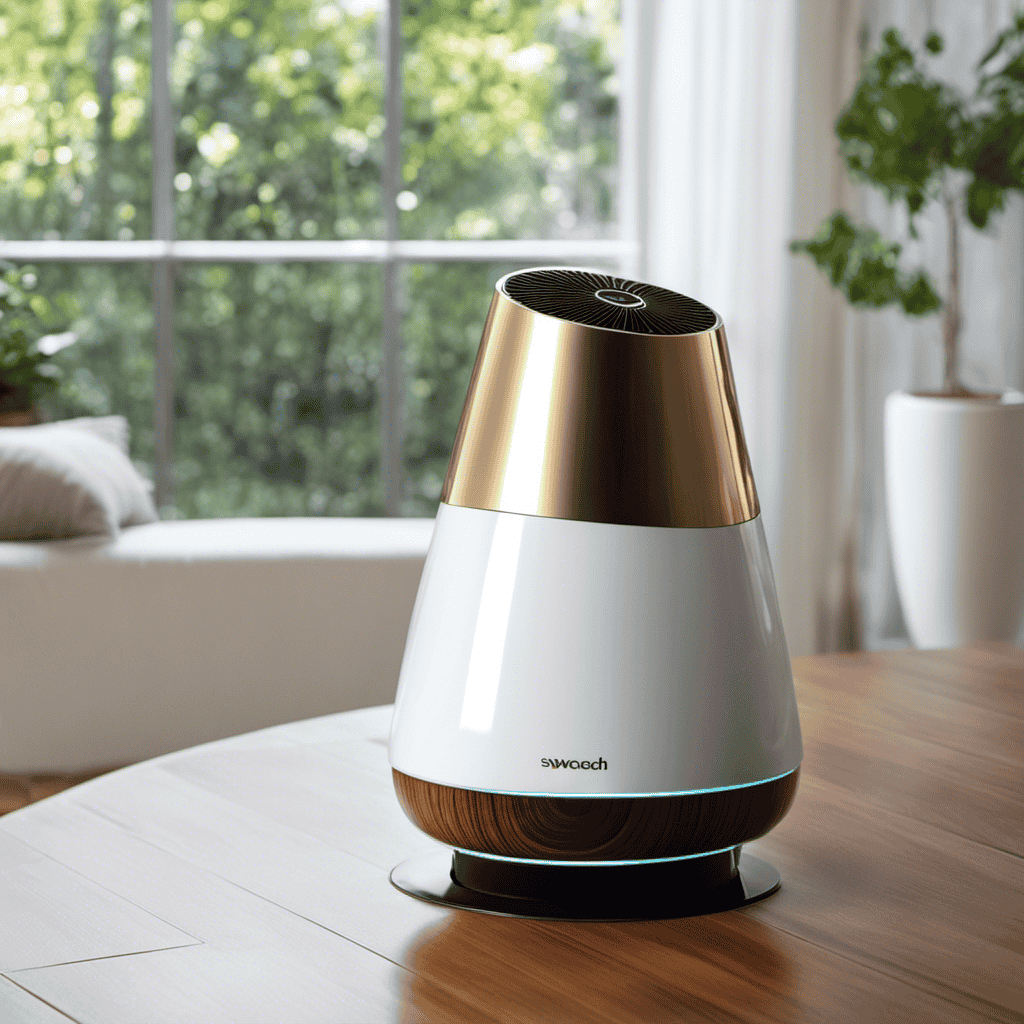
 Types of Air Purifiers4 months ago
Types of Air Purifiers4 months agoWhat Is an Air Purifier
-
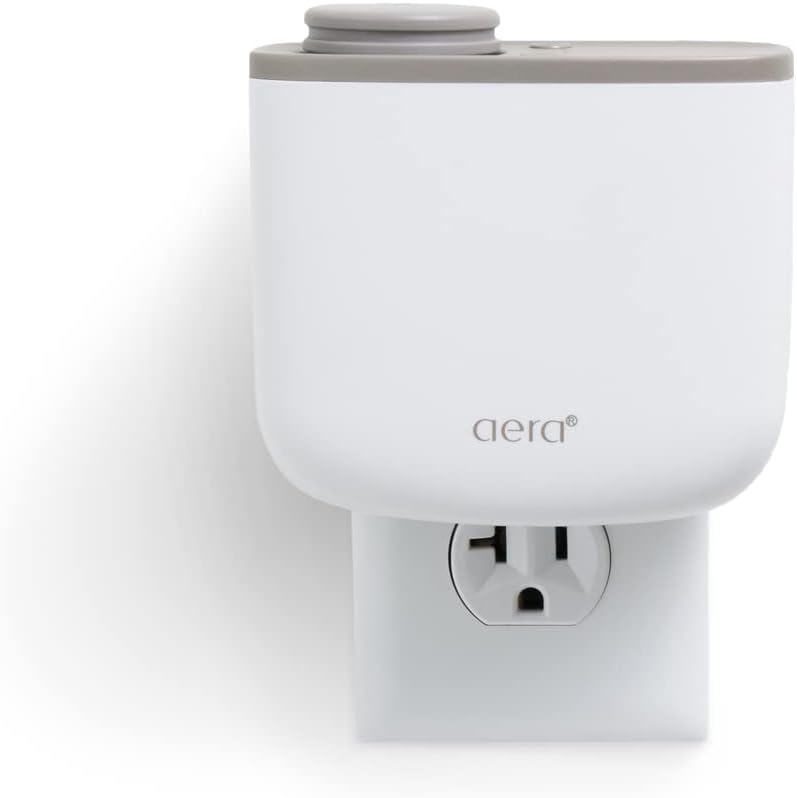
 Vetted2 months ago
Vetted2 months agoAera Mini Review: Smart Home Fragrance Diffuser With Hypoallergenic Scent Technology (2023)
-
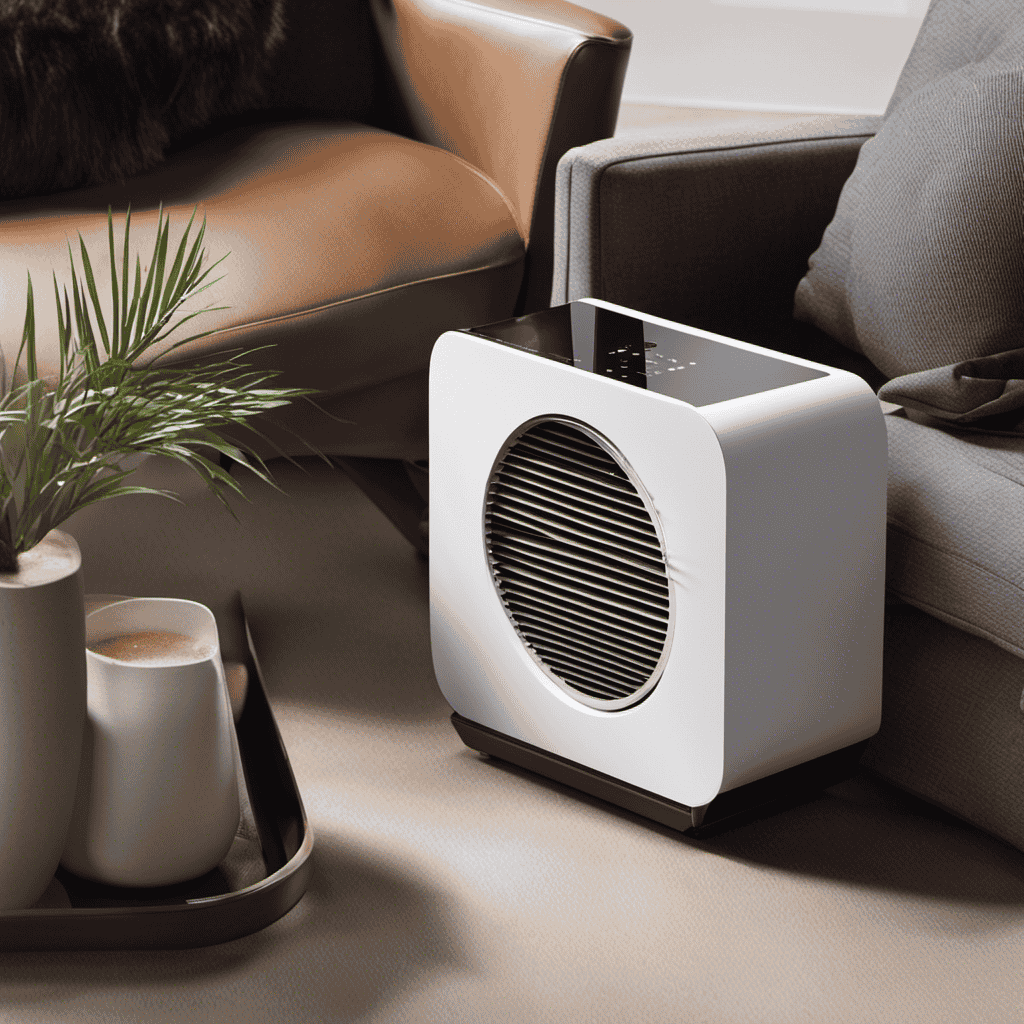
 Air Purifier Guides3 months ago
Air Purifier Guides3 months agoHow to Reset Filter on Miko Air Purifier
-
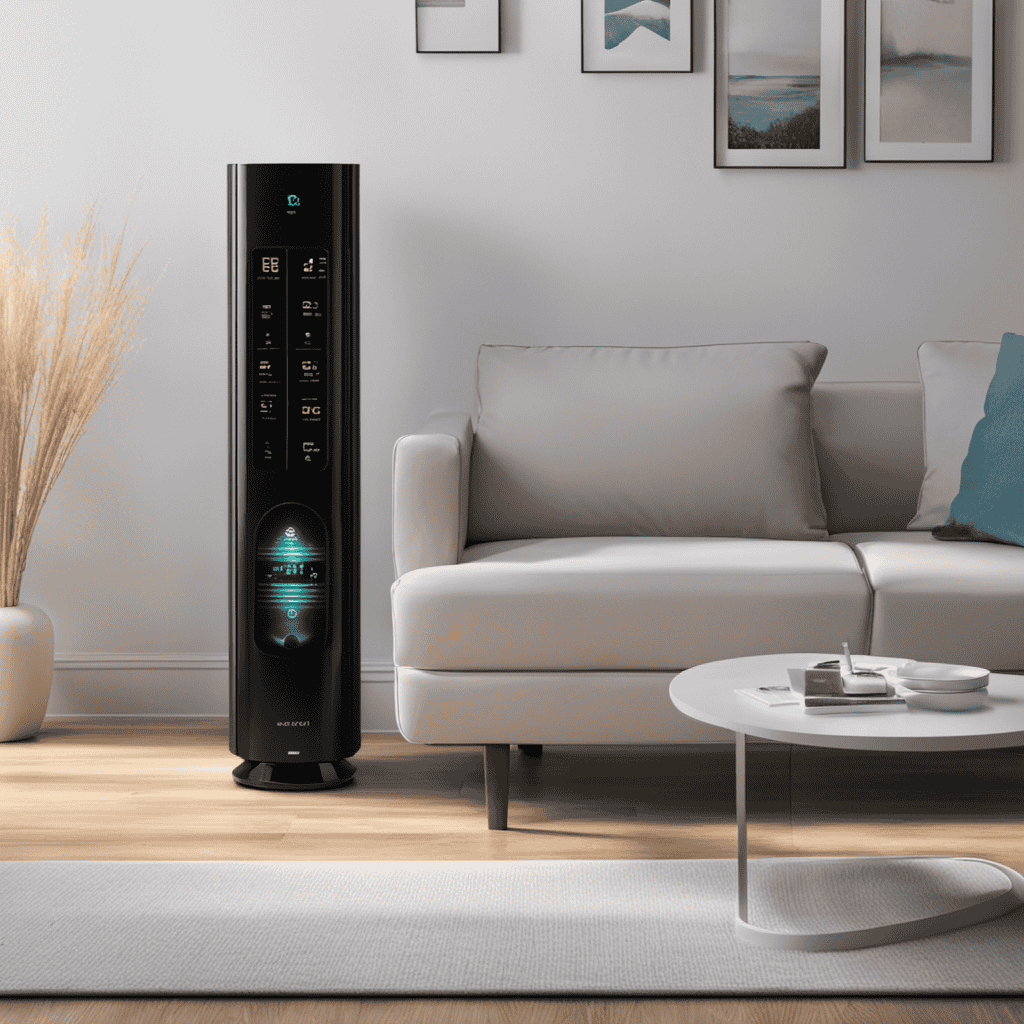
 FAQs - Advanced Queries1 week ago
FAQs - Advanced Queries1 week agoWhat Do the Numbers on My Air Purifier Mean
-
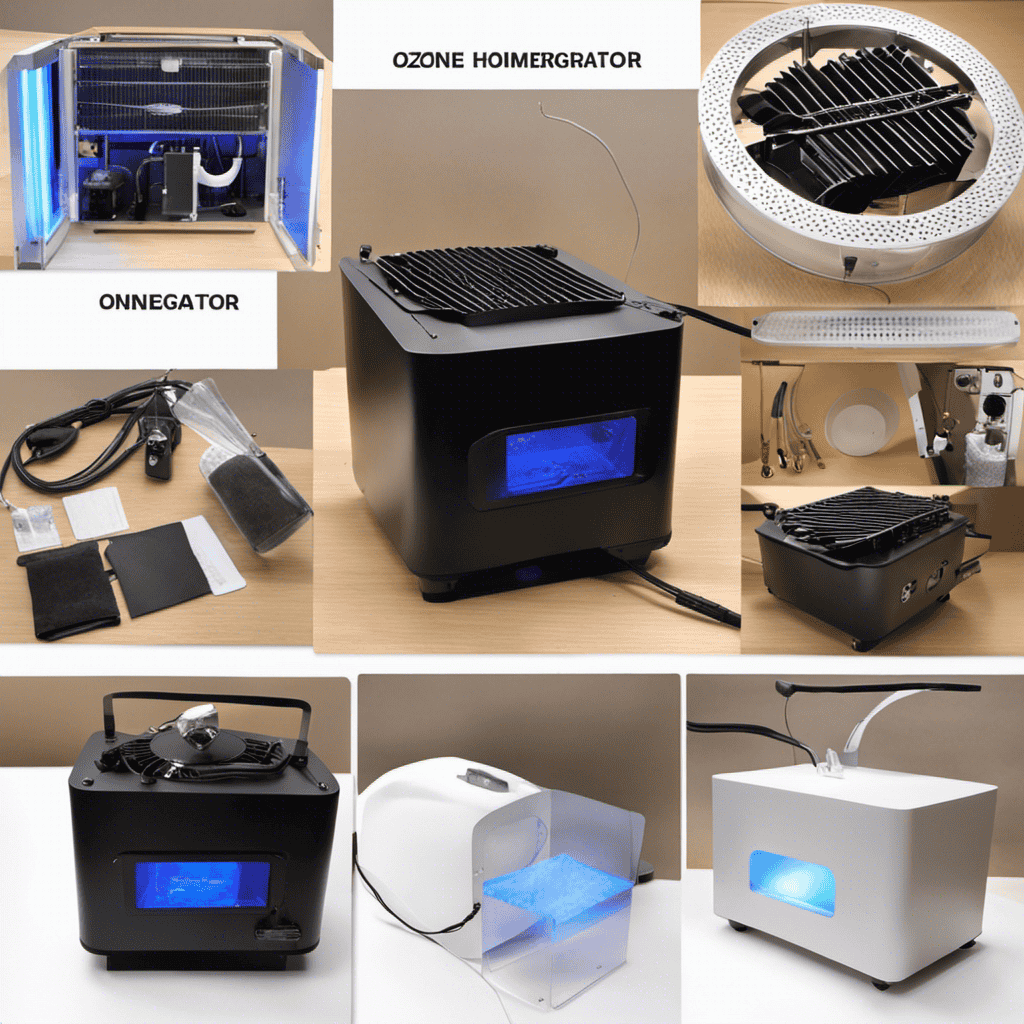
 Air Purifier Guides2 weeks ago
Air Purifier Guides2 weeks agoHow to Make a Homemade Ozone Generator (Air Purifier
-
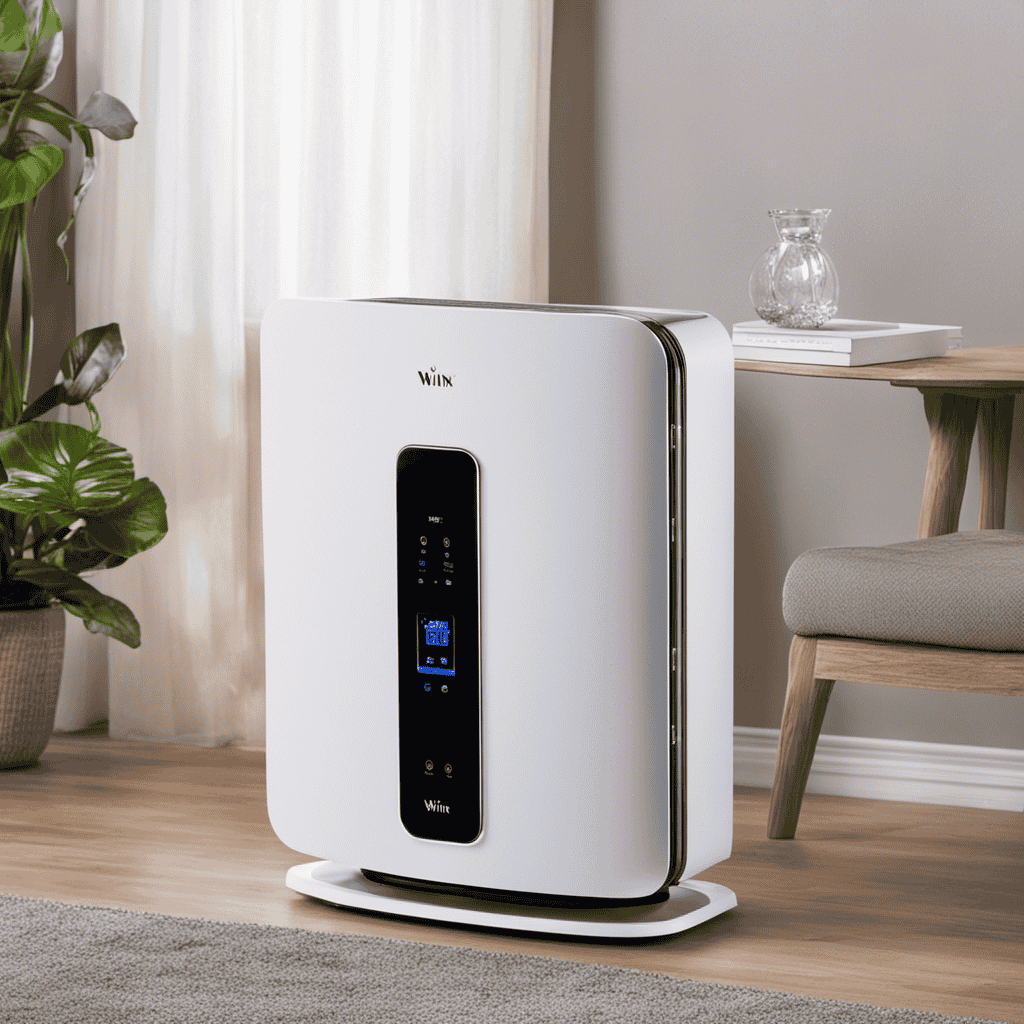
 Maintenance and Tips5 months ago
Maintenance and Tips5 months agoHow to Reset Filter Light on Winix Plasmawave Air Purifier
-

 FAQs - Advanced Queries5 months ago
FAQs - Advanced Queries5 months agoWhen to Use Ionizer on Coway Air Purifier
-
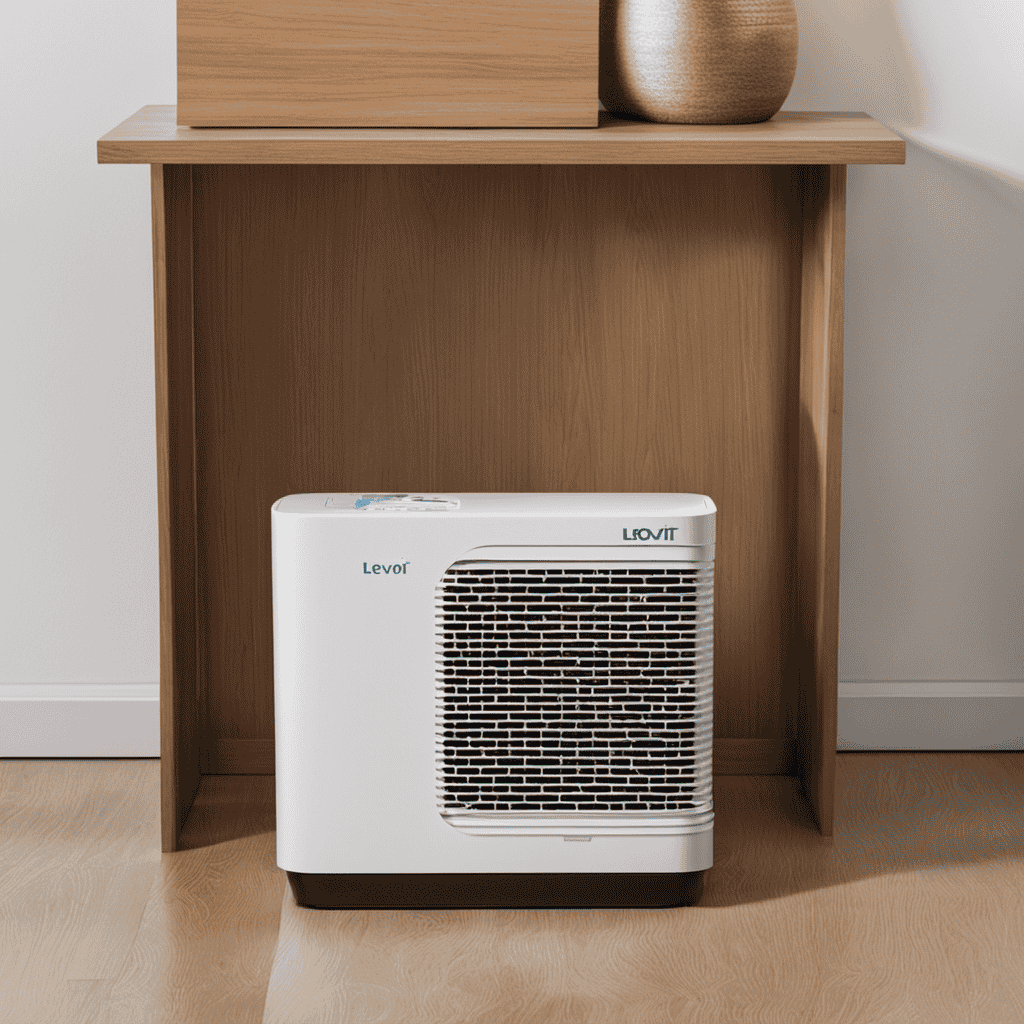
 Air Purifier Guides5 months ago
Air Purifier Guides5 months agoHow to Dispose of Air Purifier Filter Levoit









